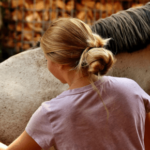1. Introduction to Sweet Itch
Explore what sweet itch is, its causes, symptoms, and how it affects horses.
2. Allergic Reaction to Culicoides Bites
Learn about the primary cause of sweet itch: an allergic reaction to the bites of Culicoides midges, also known as biting midges or no-see-ums.
3. Symptoms of Sweet Itch
Discover the common symptoms of sweet itch in horses, including itching, hair loss, skin lesions, and inflammation.
4. Identifying Sweet Itch
Understand how to identify sweet itch in horses through clinical signs and behavior changes, such as excessive rubbing, scratching, and restlessness.
5. Skin Conditions Associated with Sweet Itch
Learn about the various skin conditions associated with sweet itch, including dermatitis, eczema, and allergic reactions.
6. Pictures of Sweet Itch Affected Skin
View pictures of sweet itch affected skin to recognize the characteristic signs and symptoms, including hair loss, crusty lesions, and inflamed areas.
7. Early Detection and Treatment
Understand the importance of early detection and treatment of sweet itch to prevent worsening symptoms and complications.
8. Management Strategies
Explore management strategies for sweet itch, including environmental modifications, fly control measures, and topical treatments.
9. Fly Sheets and Masks
Learn about the use of fly sheets and masks to protect horses from Culicoides bites and minimize the risk of sweet itch flare-ups.
10. Antihistamines and Corticosteroids
Discover how antihistamines and corticosteroids can help alleviate itching and inflammation associated with sweet itch in horses.
11. Immune-Suppressing Medications
Explore the use of immune-suppressing medications to manage severe cases of sweet itch resistant to other treatments.
12. Natural Remedies and Supplements
Learn about natural remedies and supplements that may help alleviate symptoms of sweet itch in horses, such as omega-3 fatty acids and herbal supplements.
13. Prevention Strategies
Explore prevention strategies for sweet itch, including regular grooming, fly control measures, and avoiding areas with high midge populations.
14. Environmental Management
Understand the importance of environmental management in preventing sweet itch, such as maintaining clean pastures and reducing standing water.
15. Veterinary Care and Monitoring
Learn about the role of veterinary care and monitoring in managing sweet itch, including regular check-ups, skin examinations, and treatment adjustments.
16. Addressing Underlying Allergies
Explore the importance of addressing underlying allergies and sensitivities in horses with sweet itch to prevent future flare-ups.
17. Breeds Prone to Sweet Itch
Discover which horse breeds are more prone to sweet itch due to genetic predispositions and environmental factors.
18. Seasonal Variations
Understand how sweet itch severity can vary depending on seasonal factors, such as warmer temperatures and increased midge activity.
19. Impact on Quality of Life
Explore how sweet itch can impact a horse’s quality of life, causing discomfort, distress, and interference with normal activities.
20. Research and Advancements
Learn about ongoing research and advancements in the understanding and treatment of sweet itch in horses.
21. Support and Resources
Discover support networks and resources available to horse owners dealing with sweet itch, including online forums, educational materials, and veterinary guidance.
22. Holistic Approach to Management
Understand the benefits of taking a holistic approach to sweet itch management, addressing dietary, environmental, and lifestyle factors.
23. Collaboration with Equine Specialists
Explore the importance of collaborating with equine specialists, such as veterinarians and dermatologists, in managing sweet itch effectively.
24. Long-Term Care Strategies
Learn about long-term care strategies for horses with sweet itch, including ongoing monitoring, treatment adjustments, and preventive measures.
25. Conclusion: Providing Comfort and Relief
In conclusion, sweet itch is a challenging skin condition for horses, but with proper management and care, affected horses can experience relief from itching and discomfort. By implementing preventive measures, seeking veterinary guidance, and exploring treatment options, horse owners can provide their animals with the comfort and quality of life they deserve.


